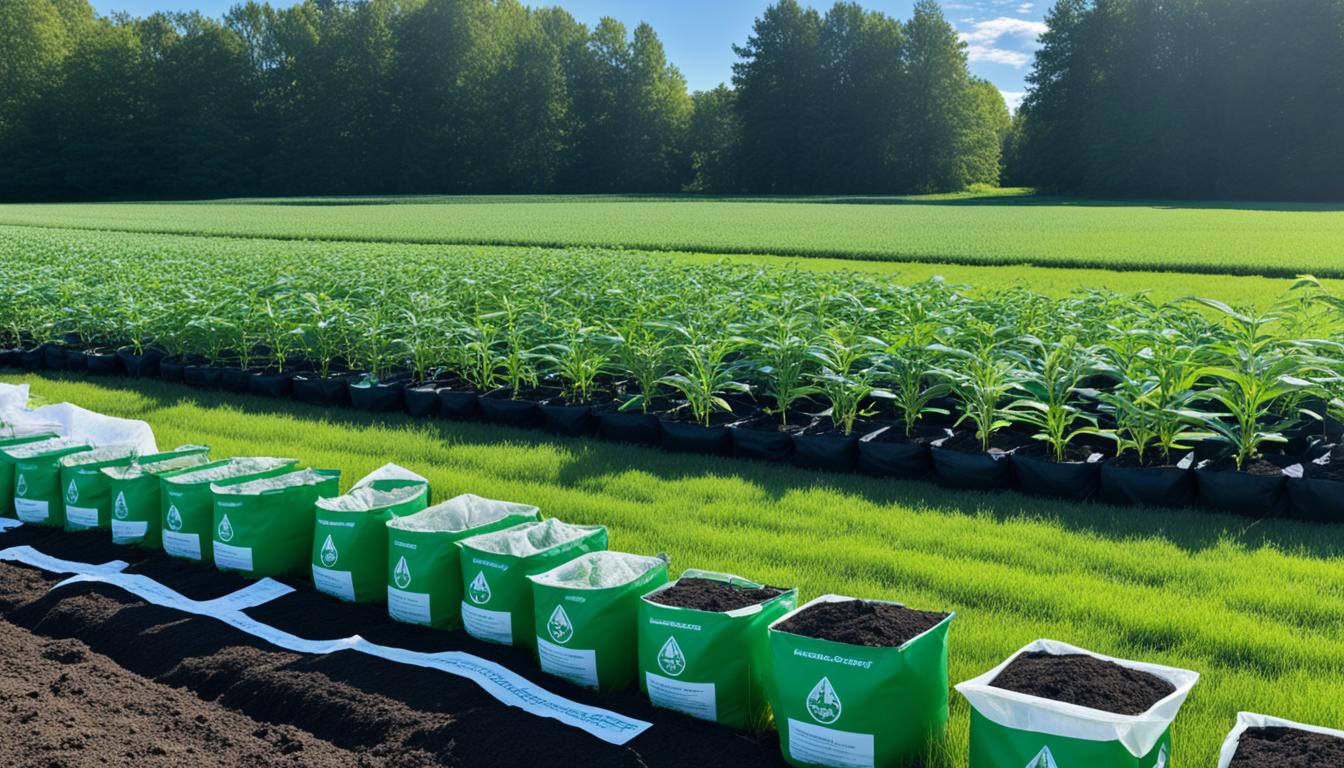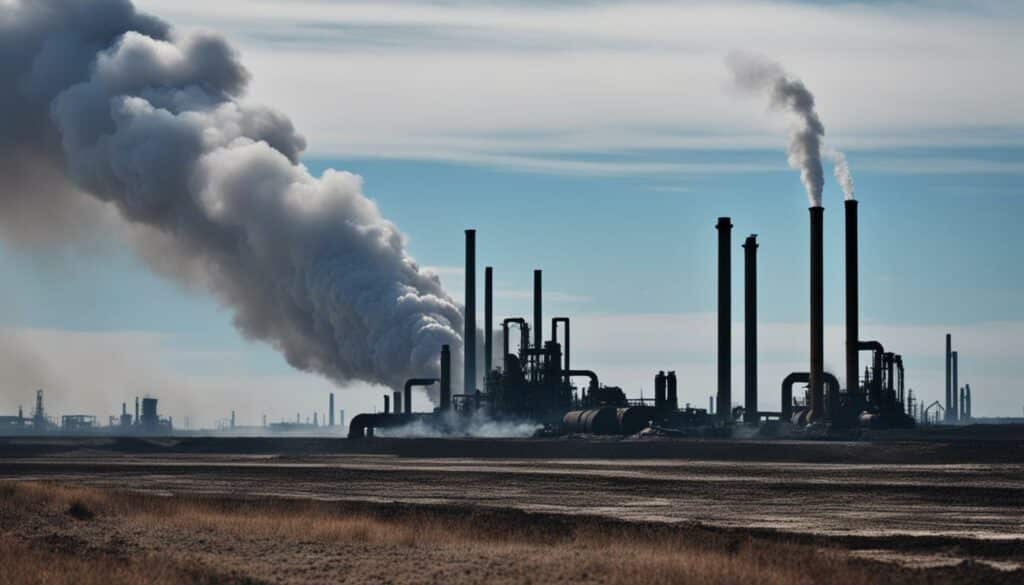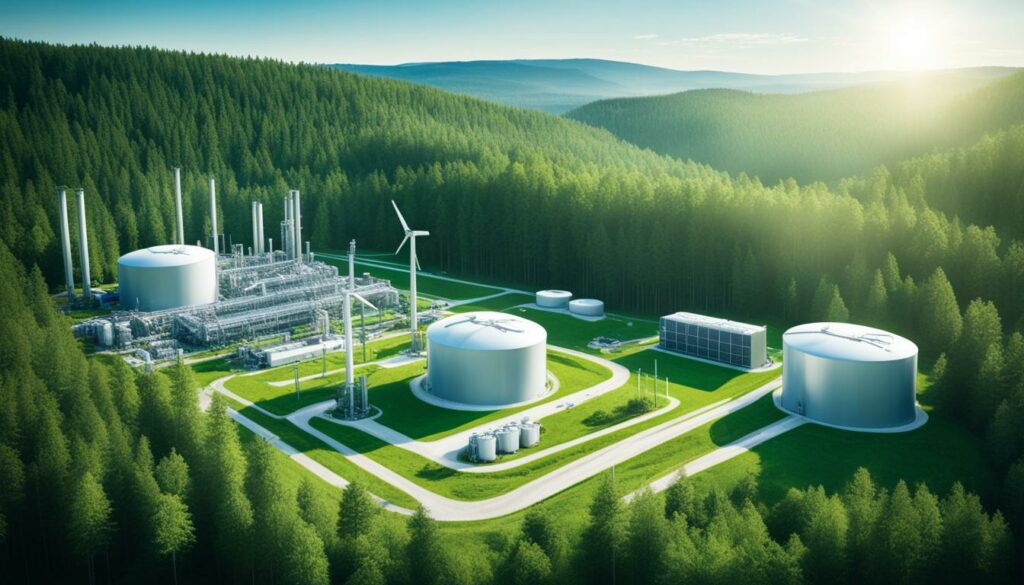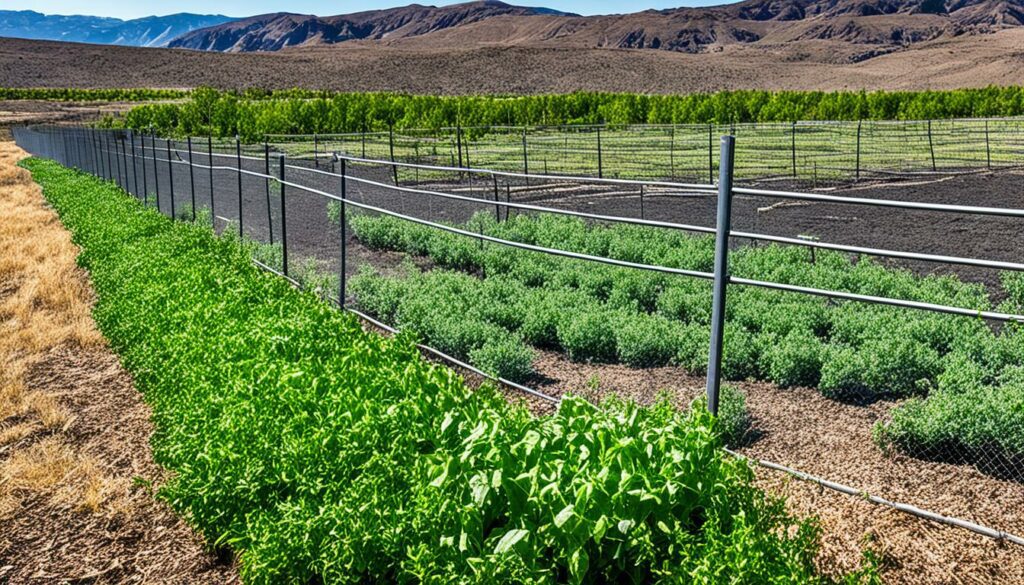Menu

In 2050, our world’s population might reach 9.7 billion. This makes the need for sustainable farming crucial. The drive for eco-friendly agriculture solutions is more important than ever. Such solutions aim to tackle climate change and protect our planet’s varied life forms.
The fertilizer industry is changing fast due to stricter environmental rules. It’s moving away from heavy use of man-made products. The focus now is on balancing supply with demand in a more eco-friendly way. One promising change is the move towards making ‘green’ ammonia.
Looking ahead, adopting new tech and finding alternatives to traditional methods will be key. Ammonia plays a big role in agriculture, and there will be intense competition for it. There’s even a chance it might become a significant global trade product. As the industry shifts, moving towards sustainable ways will be critical for its success.
Learning about fertilizer rules means exploring a long past and modern farming rules worldwide. This journey shows how rules changed to support our environment and meet today’s needs.
Fertilisers have been used for a long time, but big steps were made in the last century. In the 1900s, we started making synthetic fertilisers, making farming much more productive. From 1960 to 2000, the amount of wheat, rice, and maize we grew nearly doubled or even more. All this progress was thanks to fertilisers rich in nitrogen, phosphorus, and potassium, plus other essential elements.
But, we didn’t worry much about the downsides at first. This led to too many nutrients and harmful effects on our earth. Since we knew we’d have to feed more and more people on this planet, we had to think about the future of farming. By 2030 and 2050, we’re expecting huge population growth. This pushed us to create rules that would make farming both successful and safe for the environment.
Now, the rules around fertilisers aim to help our planet and keep on feeding everyone. Countries and global groups are working hard to use fewer synthetic fertilisers. The reason is that such fertilisers play a big part in climate change, making up 5% of the harmful gases in the world.
A big goal worldwide is to reduce the extra nutrients by half. Leaders made this clear at the Montreal Biodiversity COP 15 in 2022. Also, the U.S. Environmental Protection Agency (US EPA) is keen on farming that’s good for the earth. They have a set of 4-Rs: recover, reduce, reuse, and recycle. These methods help keep farms fertile while being gentle to the planet.
New farming ways are coming up to fit these new rules. Things like nanotechnology and bioformulation fertilisers are here. They help crops grow better and protect the environment. For example, by stopping ammonia from turning into nitrate, we can use less nitrogen. These eco-friendly fertilisers are the future of farming.
The move to make farming kinder to the planet is changing how we grow our food. It’s leading agriculture towards a more sustainable future. This journey is essential as we look to feed more people while taking care of our earth.
The fertiliser industry faces changing rules, which affect its profits. Many challenges, like high costs and new trade rules, mean companies must be smart to keep growing.

Regulations really hit the industry’s wallet. They have to follow rules, like reducing harmful farm chemicals, which costs a lot. The push for greener practices also affects how much fertilisers are needed and costs to run the business.
Doing business the old way is not sustainable. Synthetic fertilisers are bad for the planet, adding to global warming. The cost of these fertilisers went up by 80% in 2021, and in 2022, they were at their highest in a long time, putting more pressure on the industry.
Supply chains are also reorganising to meet new rules. Fertiliser prices swing because of supply issues and rules to follow. Changes include seeking supplies from other places, like China, which is a big producer.
Companies are now working to be greener. They’ve cut down on harmful emissions by making fertilisers more efficiently. New plants are much smarter with energy use, meeting higher green standards.
In the end, meeting new rules and greening the industry is tough but important. By being inventive and following the rules, these companies can survive and protect the environment.
| Year | Commitment by IFC (in billion $) | Wheat Yield Increase (%) | Global Export Value (in billion $) |
|---|---|---|---|
| 2022 | 32.8 | – | 94.6 (2021) |
| 1960-2000 | – | 208 | – |
To learn more about how regulations are shaking up the fertiliser industry and innovative supply chain solutions, check out this document.
The fertiliser industry is changing to be more eco-friendly. New tech is key in this shift. Things like precision farming, biostimulants, and leaching inhibitors offer big help.
Precision farming is making big strides. It uses tech to manage fields in more detail. This includes using data, GPS, and sensors to apply just the right amount of nutrients. It cuts waste and helps the environment.
This method is catching on fast. Experts see the global fertiliser market growing steadily due to these practices. Precision farming could also help if there’s less nitrogen available in the future.
Think of biostimulants as boosters for plant growth. They use things like bacteria and seaweed to make crops stronger. These products help plants use nutrients better. As a result, they reduce the amount of nutrients we don’t need.
This is important for our planet’s future food production. With the world’s population growing, we need to use our resources wisely. Biostimulants help us farm in a more sustainable way.
Leaching inhibitors, like certain chemicals, stop important nutrients from washing away. These help more nutrients stay where plants can use them. As we aim to use less synthetic fertilisers, these inhibitors are a good path to follow. They also back the EPA’s guidelines for better fertiliser use.
All these innovations are making fertilisers greener. They cut down harm to the earth and keep farming going strong. The future of farming will be shaped by these new technologies.
Green and blue ammonia are changing the game in the fertiliser world by grabbing worldwide attention. They are eco-friendly alternatives challenging the status quo. With green and blue methods, we’re seeing a big change towards more sustainable practices.

Green ammonia is made using clean energy sources like the wind and sun. This cuts its climate impact a lot. By 2030, its growth is predicted to be huge, with 112% each year. Big companies are already investing in it. For example, a huge plant in Saudi Arabia is set to make 1.2 million tonnes a year starting in 2025. A smaller test plant in the US has shown this can really work since 2013.
Grey ammonia comes from polluting sources and emits a lot of CO2. But blue ammonia is changing the game. It’s made in a greener way that also captures and stores CO2. This makes it a crucial step before we fully transition to green ammonia. By 2050, in ships alone, it could make up most of the fuel used. This shows its growing role in protecting our planet.
Green and blue ammonia are reshaping the fertiliser landscape and future market trends. They have over 161 projects ongoing and aims to produce 244 million tonnes a year by 2030. At the same time, the need for ammonia in ship fuel is expected to boom by 2050. Even so, over 30% would still be made by old, not-so-green means. This shows there’s a lot to do yet in making fertilisers truly eco-friendly.
| Ammonia Type | Production (MTPA by 2050) | Key Applications |
|---|---|---|
| Green Ammonia | 26% of total | Fertiliser, Hydrogen Carrier, Maritime Fuel |
| Blue Ammonia | 76% of maritime fuel supply | Maritime Fuel, Fertiliser |
| Grey Ammonia | 30% of total feedstock by 2050 | Traditional Uses |
Green and blue ammonia’s increased use shows a wide commitment to our planet in farming and beyond.
The use of organic fertilisers is on the rise, showing a big move towards more environmentally friendly farming. We will look into the big advantages of organic fertilisers, the problems they face, and how they stand up economically in farming today.
Organic fertilisers help in keeping farming sustainable. They improve the health of the soil and reduce harmful substances in the air and water. It is estimated that the market for organic fertilisers will grow to US$27.48 billion by 2030. This is because people are more aware of the need to protect the environment and enjoy organic foods. The European Union is putting 30% of its farm support money into encouraging organic farming, showing how important it is.
Organic fertilisers face some hurdles. Their cost is often higher than chemical fertilisers, making it tough for small farm owners in less wealthy areas to switch. Plus, many people still need to learn how to use them effectively. In Asia, 600 million farmers used organic manure last year. But, there are many steps to take before organic fertilisers can really take off.
The price of using organic fertilisers across large areas is a key issue. Even though the sale of organic food is growing, organic fertilisers are still not the top choice for all farmers. Yet, government rules and support can make a big difference. In the US alone, organic food sales bring in almost US$40 billion each year. By focusing on new technologies and working together, the use of organic fertilisers can be raised in a sustainable way.
| Region | Organic Agriculture Support | Organic Fertiliser Market Growth |
|---|---|---|
| Europe | 30% of CAP budget allocation | Driven by EIP-AGRI initiatives |
| Asia | 600M people using manure | Significant growth in China and India |
| North America | USDA and NOP guidelines | Contributing US$40 billion annually |
Environmental rules have a big impact on how fertilisers are used. They are key for both farming and looking after our planet. It’s important to control the runoff of nutrients to prevent the bad effects of too much fertiliser. Guo et al. (2021) showed that subsidies can affect how much chemical fertiliser farmers use. This shows why we need strict rules.
In China’s Huai River area, Chen et al. (2013) found that heavy use of fertiliser causes air pollution. This pollution can shorten lives. Mao, Sun & Zhang (2020) looked at air quality in the Yangtze River area. They showed how important it is to have good air when growing crops.

Huang et al. (2020) looked at the risks near mines to health and the environment. This shows the big-picture problems that mineral fertilisers can bring. In the Yangtze area, Cui et al. (2022) gave good signs for better farming that cares for the environment.
Li et al. (2020a) discussed taking out nitrogen from water in a smart way. The way we manage nutrients is critical. Good practices can cut the harm we do to the environment. Also, Liu et al. (2022) looked at rules’ effects on how well farms do. They prove how crucial strong regulations are for good farm methods.
As the world’s population grows, we need more food. This leads to more farming, which can harm the soil and wildlife. Trying to grow more food often causes big problems for the planet. These include too much nitrogen in the environment, which can be harmful.
| Study | Focus | Implication |
|---|---|---|
| Chen et al. (2013) | Air pollution and life expectancy | Reduced life expectancy in polluted regions |
| Cui et al. (2022) | Agricultural development indicators | High-quality agriculture aligning with regulations |
| Fan et al. (2021) | Pollution control and economic growth | Policies balancing economic and environmental goals |
| Guo et al. (2021) | Effect of agricultural subsidies | Influences on chemical fertiliser use |
| Huang et al. (2020) | Risks from metal exposures | Health and environmental hazards |
It’s vital to reduce the bad effects of fertiliser while still farming well. Eddy (2022) found new ways to lower harmful nitrogen. Using resources better is key. It helps us feed more people without damaging our planet too much.
In the drive for sustainable agriculture, we look to methods like *integrated pest management* and *conservation tillage*. These methods are key in lessening harm to the environment. At the same time, they keep farm productivity high. They highlight the need to boost soil health and cut down on chemicals.
*Integrated pest management* (IPM) uses a variety of ways to handle pests. It leans heavily on natural and helpful organisms. This cuts down on using chemical pesticides. It keeps both ecosystems and our health on track, fitting well with sustainable farming’s aims.
Conservation tillage aims to keep the top layer of soil safe and limit erosion. By leaving crop leftovers on the ground, it shields and enriches the soil. It also helps hold onto water better. These methods show how we can make food without harming the land, pushing for strong and flexible farming systems.
| Practice | Benefits | Challenges |
|---|---|---|
| Integrated Pest Management | Reduces chemical use, promotes biodiversity, supports ecosystem health | Requires detailed knowledge, can be labour-intensive |
| Conservation Tillage | Enhances soil health, reduces erosion, improves water retention | Potential initial costs, requires specific equipment |
Choosing to use these *sustainable farming practices* is a big step forward in farming’s future. Things like *integrated pest management* and *conservation tillage* help farmers better the environment, make a living, and promote fairness. They stand as the foundation of sustainable agriculture.
The future of fertilisers is changing towards more sustainable options. With the world’s population set to rise to 8.5 billion by 2030 and 9.7 billion by 2050, new ways are needed. Phosphate, found in fertilisers, comes from a resource that can run out. It lasts between 40 and 400 years. So, it’s vital to find ways that are sustainable for the rules.
Today, making fertilisers uses a lot of energy and resources, especially the Haber-Bosch process. We need new, greener ways. The U.S. Environmental Protection Agency talks about using fertilisers that are friendlier, like those made from waste. These are better for the planet. There’s also a type of fertiliser that’s very small and can help crops grow better. It uses less fertiliser and is kinder to our planet, too.
Adding organic waste to fertilisers is another bright idea for the planet. Both big and small companies are now doing this to meet new laws. At the same time, creating ammonia in a green way is a huge step forward. It will change how we see fertiliser production in the future.
In the coming years, we must make sure that our fertilisers are good for the environment. This means using new rules to focus on reusing materials, technology to release fertilisers slowly, and organic options. Such steps will help us keep feeding the world, and at the same time, take care of where we live. Adapting to these new ways of making fertilisers is essential for a green farming future.
Fertiliser rules are moving towards being kinder to the planet. They focus on using fewer nutrients and reducing gases that harm the planet. This change is to help our environment and meet global goals.
Over time, rules for fertilisers have gotten more complex. Now they look at things like gases that harm the planet and the loss of nutrients. The changes show how much the industry cares about the environment and sustainability.
Changes in fertilisers can make businesses spend more and do things differently. This can affect how fertilisers are traded and create new costs. Companies will have to find new ways to farm sustainably, which might be expensive.
Technologies like precision farming use new methods to apply fertilisers better. They also use less synthetic fertilisers. This helps the environment and fits in with sustainable farming.
Green and blue ammonia help make fertilisers in a greener way. They are a response to global calls for less pollution and better farming. They aim to be both affordable and better for the earth.
Organic fertilisers make our land more diverse, pollute less, and keep soil healthy. They are part of a move to farm in greener ways. But, challenges like cost and demand still exist.
Laws control how much fertiliser can be used and how to limit its impact. These rules try to meet the world’s food needs without harming nature.
Tactics like using fewer chemicals and caring for the soil help the environment. They back up the rules that aim for farming that doesn’t hurt the planet.
Upcoming rules will push for farming that uses new and green methods. To meet these rules, the industry will turn to things like precise farming and organic fertilisers. This way, agriculture can be good for our planet in the long run.